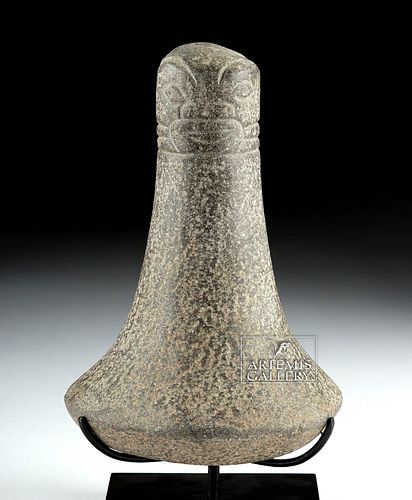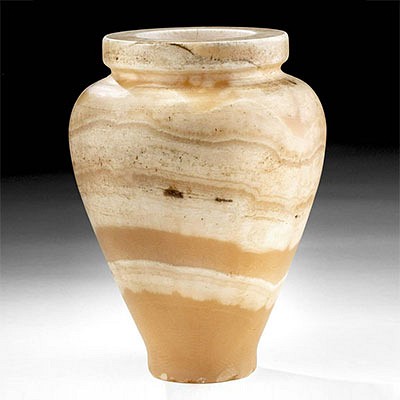18th C. Marquesas Islands Enata Basalt Poi Pounder
Lot 135a
About Seller
Artemis Gallery
686 S Taylor Ave, Ste 106
Louisville, CO 80027
United States
Selling antiquities, ancient and ethnographic art online since 1993, Artemis Gallery specializes in Classical Antiquities (Egyptian, Greek, Roman, Near Eastern), Asian, Pre-Columbian, African / Tribal / Oceanographic art. Our extensive inventory includes pottery, stone, metal, wood, glass and textil...Read more
Categories
Estimate:
$1,500 - $2,000
Absentee vs Live bid
Two ways to bid:
- Leave a max absentee bid and the platform will bid on your behalf up to your maximum bid during the live auction.
- Bid live during the auction and your bids will be submitted real-time to the auctioneer.
Bid Increments
| Price | Bid Increment |
|---|---|
| $0 | $25 |
| $300 | $50 |
| $1,000 | $100 |
| $2,000 | $250 |
| $5,000 | $500 |
| $10,000 | $1,000 |
| $20,000 | $2,500 |
| $50,000 | $5,000 |
| $100,000 | $10,000 |
| $200,000 | $20,000 |
About Auction
By Artemis Gallery
Dec 17, 2020
Set Reminder
2020-12-17 10:00:00
2020-12-17 10:00:00
America/New_York
Bidsquare
Bidsquare : VARIETY SALE | Antiquities & Ethnographic Art
https://www.bidsquare.com/auctions/artemis-gallery/variety-sale-antiquities-ethnographic-art-6207
Featuring classical antiquities, ancient and ethnographic art from cultures encompassing the globe. Egyptian, Greek, Roman, Etruscan, Near Eastern, Asian, Pre-Columbian, Native American, African / Tribal, Oceanic, Spanish Colonial, Russian, Fossils, Fine Art, more! Artemis Gallery info@artemisgallery.com
Featuring classical antiquities, ancient and ethnographic art from cultures encompassing the globe. Egyptian, Greek, Roman, Etruscan, Near Eastern, Asian, Pre-Columbian, Native American, African / Tribal, Oceanic, Spanish Colonial, Russian, Fossils, Fine Art, more! Artemis Gallery info@artemisgallery.com
- Lot Description
French Polynesia, Marquesas Islands, Enata peoples, ca. late 18th to early 19th century CE. An intriguing and elegant poi pounder, hand-carved from dark-grey basalt stone, used for repeatedly pounding taro root into poi. The tool is defined by a rounded pounding face, wide shoulders, a smooth tapered profile, a thick tubular handle, and a bifurcated knob adorned with a pair of carved abstract Janiform faces. Each abstract face is composed of almond-shaped eyes, rectangular noses, and ovoid mouths with full lips, with furrowed eye brows and a mutual set of horizontal scarification lines stretching across the cheeks. Both the handle and pounding face are relatively smooth to the touch as a result of repeated use. Custom museum-quality display stand included. Size: 4.4" W x 6.3" H (11.2 cm x 16 cm); 7.5" H (19 cm) on included custom stand.
Poi pounders, alongside adzes, were the most important stone tools in Polynesia and the Hawaiian Islands (Europeans introduced steel weapons). The pounder, known locally as a "Ke'a Tuki Popoi," are used for pounding cooked taro root into poi, a staple of the islander diet. Taro root was steamed in an earthen oven, peeled using shells, and placed onto a slab of wood to be pounded. The pounded results were blended with water into a highly nutritious paste. Traditional calabash bowls were used as containers to hold poi mixtures, and traveling royalty were accompanied by their own poi maker, with his or her own poi-making implements like this one.
For a similar Janiform example, please see The Metropolitan Museum of Art, accession number 1995.65.1: https://www.metmuseum.org/art/collection/search/317734
Provenance: private Newport Beach, California, USA collection
All items legal to buy/sell under U.S. Statute covering cultural patrimony Code 2600, CHAPTER 14, and are guaranteed to be as described or your money back.
A Certificate of Authenticity will accompany all winning bids.
We ship worldwide and handle all shipping in-house for your convenience.
#133631Surface wear and abrasions commensurate with age as expected, very minor nicks to shoulder and handle, minor fading to some carved details, and light roughness across most surfaces, otherwise intact and excellent. Nice earthen deposits and light mineral deposits throughout.Condition
- Shipping Info
-
All shipping is handled in-house for your convenience. Your invoice from Artemis Gallery will include shipping calculation instructions. If in doubt, please inquire BEFORE bidding for estimated shipping costs for individual items.
-
- Buyer's Premium



 EUR
EUR CAD
CAD AUD
AUD GBP
GBP MXN
MXN HKD
HKD CNY
CNY MYR
MYR SEK
SEK SGD
SGD CHF
CHF THB
THB















